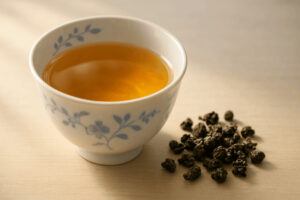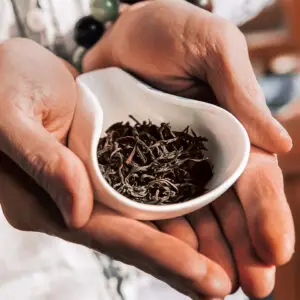We’ve all been there: that uncomfortable feeling after a meal – a bit too full, perhaps some bloating, maybe just a general sense of sluggishness in our digestive system. It’s a common human experience. While grabbing for over-the-counter remedies is one option, many are increasingly looking towards gentler, more natural ways to support their digestive well-being. And nestled comfortably in kitchens worldwide is a potential ally: tea.
But can a simple cup of tea really make a difference to something as complex as digestion? Is it just comforting warmth, or is there more to it? The answer, reassuringly, is yes – certain teas, both traditional “true teas” from the Camellia sinensis plant and various herbal infusions (tisanes), possess properties that have been traditionally used and increasingly studied for their digestive benefits.
This article will explore the fascinating relationship between tea and digestion. We’ll journey from simple understandings for the casually curious to deeper insights for the dedicated tea lover, addressing common questions along the way:
- Which teas are best known for digestive support?
- How exactly do they work? Is it scientifically backed?
- Are there differences between herbal teas and regular black or green tea?
- Are there any tips for brewing or things to watch out for?
Whether you’re just wondering if that post-dinner cuppa helps, or you’re keen to understand the specific compounds at play, let’s steep ourselves in the soothing world of digestive teas.
Can Tea Really Help My Tummy?
For many, tea is synonymous with relaxation or a morning caffeine boost – think English Breakfast or a calming Chamomile before bed. So, the idea that it might help with digestion can be a pleasant surprise.
Yes, certain teas can genuinely offer digestive relief for common issues like bloating, gas, or mild indigestion. It’s not typically an instant, powerful fix like a strong medication (unless we’re talking about specific laxative teas, which need caution – more on that later!). Instead, think of it as a gentle nudge, helping your system find its balance.

- Is it proven? Some teas have more scientific backing than others. Peppermint and Ginger, for example, have been studied quite a bit for their effects on things like indigestion and nausea. For others, the evidence might come more from centuries of traditional use, which is still valuable, but perhaps less clinically proven in the modern sense. Many teas work by helping to relax the muscles in your gut, gently stimulating movement, or providing soothing anti-inflammatory effects.
- Which ones? Common go-to’s often include Peppermint, Ginger, and Chamomile teas. But as we’ll see, teas like Green Tea, Black Tea, and especially fermented teas like Pu-erh also play a role.
- How quickly does it work? It varies. Sometimes, a warm cup of peppermint tea can bring relatively quick relief from bloating. Other benefits, like supporting a healthy gut environment with green tea, are more about consistent, long-term consumption.
- Any downsides? Generally, most common digestive teas are very safe when consumed in moderation. However, some people might find certain teas don’t agree with them. For instance, peppermint can sometimes worsen heartburn for those prone to it. And, of course, caffeinated teas might not be ideal for everyone, especially close to bedtime or if you have certain sensitivities.
- Is it just about drinking it? Pretty much! Simply preparing and sipping a cup, especially after a meal or when feeling discomfort, is the usual way. The warmth itself can also be soothing.
So, yes, that comforting cup can be more than just a habit; it can be a gentle helping hand for your digestive system. just three days4. This shows tea’s power in supporting digestive health and overall well-being.
Diving Deeper: Which Teas and Why?
Okay, so we know some teas help. But which specific types should you reach for, and what makes them effective? Let’s differentiate between two main categories:
- Herbal Infusions (Tisanes): These aren’t technically “tea” in the strictest sense, as they don’t come from the Camellia sinensis plant. They are infusions of various herbs, spices, fruits, or flowers in hot water. Many of the most famous “digestive teas” fall into this category.
- True Teas: These all originate from the Camellia sinensis plant, but are processed differently to become Green Tea, Black Tea, Oolong Tea, White Tea, Pu-erh Tea, etc. They contain caffeine (to varying degrees) and unique plant compounds called polyphenols.
How do they work? Let’s look at the mechanisms in simple terms:
- Relaxing Muscles: Some teas, notably Peppermint, contain compounds (like menthol) that help relax the smooth muscles of your digestive tract. This can ease spasms, reduce bloating, and help things move along more comfortably. Think of it as gently loosening a tense knot in your tummy.
- Stimulating Movement (Motility): Other teas, like Ginger and caffeinated true teas (Black, Green, Oolong), can gently stimulate the muscles to contract and move food through your system more efficiently. Ginger is particularly known for helping speed up stomach emptying.
- Reducing Inflammation: Chronic inflammation in the gut can contribute to digestive issues. Many teas, especially Green Tea with its potent EGCG catechins, and herbs like Ginger and Chamomile, possess anti-inflammatory properties that can soothe the digestive tract lining over time.
- Aiding Fat Digestion: Traditionally, some teas like Pu-erh have been consumed after heavy, greasy meals. Research suggests certain compounds in these teas might help by interacting with enzymes involved in fat breakdown or by influencing bile flow.
- Supporting Gut Bacteria: This is a fascinating and growing area! The trillions of bacteria in our gut (the microbiome) play a huge role in digestion. Compounds in true teas (Green, Black, Oolong, Pu-erh) can act as prebiotics – food for beneficial gut bacteria – helping to foster a healthier gut environment, which indirectly supports better digestion.
- Simple Hydration: Never underestimate this! Dehydration can lead to constipation. Any cup of tea contributes to your daily fluid intake, helping keep everything moving smoothly.
Brewing for Benefits:
Does how you brew it matter? Yes, a little.
- Herbal Teas: Generally forgiving. Use boiling water (around 212°F or 100°C) and steep for 5-10 minutes to extract the volatile oils and compounds effectively. Cover the cup while steeping to keep those beneficial oils from escaping with the steam.
- True Teas: More nuanced.
- Green Tea: Use cooler water (around 175°F or 80°C) for 2-3 minutes. Boiling water can make it taste bitter and might degrade some delicate compounds.
- Black Tea: Use boiling water (212°F or 100°C) for 3-5 minutes.
- Oolong Tea: Water temperature and steeping time vary greatly depending on the type (from greener oolongs needing cooler water to darker ones tolerating hotter). Generally, start around 195°F (90°C) for 3-5 minutes.
- Pu-erh Tea: Use boiling water, often with a quick initial rinse of the leaves, then steep for several minutes. These teas can often be steeped multiple times.
Quality and Sourcing:
Does it matter if you buy supermarket tea bags versus loose-leaf tea? It can. Loose-leaf teas often contain higher quality, larger leaf pieces, potentially offering more complex flavors and a fuller spectrum of compounds compared to the “dust” often found in standard tea bags. However, reputable brands of tea bags can still be effective and convenient. Look for organic options if possible, especially for herbals, to avoid pesticides.
Too Much of a Good Thing?
While generally safe, overconsumption can have downsides. Too much caffeine from true teas can cause jitters, anxiety, or worsen diarrhea for some. Certain very strong herbal laxative teas (like Senna) should only be used occasionally and short-term, as they can lead to dependency. As always, moderation is key.
The Connoisseur’s Corner: Mechanisms, Nuances, and the Gut Microbiome
For those who appreciate the finer details, let’s delve into the specifics. The digestive benefits of tea stem from a complex interplay of bioactive compounds interacting with our physiology.
Spotlight on Herbal Stars:
- Fennel (Foeniculum vulgare): Traditionally used as a carminative (to reduce gas). Compounds like Anethole are thought to relax intestinal muscles and help expel trapped gas, relieving bloating and discomfort.
- Peppermint (Mentha piperita): Its star compound is Menthol. Research, particularly using enteric-coated peppermint oil capsules (delivering a higher concentration than tea), strongly supports its efficacy in alleviating symptoms of Irritable Bowel Syndrome (IBS), particularly spasms, bloating, and discomfort. The mechanism primarily involves calcium channel blockade in smooth muscle cells of the gut wall, leading to muscle relaxation (spasmolysis). It may also modulate pain perception via TRPM8 channels. Caveat: By relaxing the lower esophageal sphincter, it can worsen symptoms for individuals with GERD (acid reflux).
- Ginger (Zingiber officinale): The key bioactives are Gingerols and Shogaols. There’s robust evidence for Ginger’s anti-nausea effects (motion sickness, pregnancy, chemotherapy-induced). It acts as a prokinetic, accelerating gastric emptying and stimulating intestinal motility, likely through interactions with serotonergic (5-HT3/4) and cholinergic receptors. Its anti-inflammatory action (inhibiting COX and LOX pathways) also contributes to soothing the gut.
- Chamomile (Matricaria chamomilla): Contains compounds like Apigenin and Bisabolol. Known for its mild sedative properties (potentially reducing stress-related digestive upset), it also possesses anti-inflammatory and antispasmodic effects, likely relaxing gut muscles. Evidence for specific digestive conditions is less robust than for peppermint or ginger, but its traditional use is widespread.
Exploring Camellia Sinensis – The True Teas
Beyond hydration and caffeine’s mild stimulant effect on motility, true teas offer unique benefits largely attributed to their rich polyphenol content.
- Pu-erh Tea:
This tea undergoes a unique post-fermentation process involving microbial activity (either slow aging – sheng/raw pu-erh, or accelerated fermentation – shou/ripe pu-erh). This process creates unique compounds like Theabrownin and may alter the polyphenol profile significantly. Traditionally consumed in Southern China to aid digestion, especially of rich or fatty foods, Pu-erh is thought to work partly by modulating the gut microbiota (potentially introducing beneficial microbes or their metabolites) and possibly by inhibiting digestive enzymes like pancreatic lipase, which breaks down fats. Some studies suggest it can help regulate lipid metabolism.

- Green Tea:
Minimally oxidized, it retains high levels of catechins, particularly Epigallocatechin gallate (EGCG). EGCG is a potent antioxidant and anti-inflammatory agent, potentially protecting the gut lining. Crucially, green tea polyphenols are increasingly recognized for their positive impact on the gut microbiome. They resist digestion in the upper gut, reaching the colon where they are metabolized by bacteria into smaller, bioactive compounds. They can act as prebiotics, promoting the growth of beneficial bacteria like Bifidobacterium and Lactobacillus, while potentially inhibiting some harmful strains. This modulation contributes to a healthier gut environment long-term.
- Black Tea:
Fully oxidized, its catechins are converted into Theaflavins and Thearubigins. These larger polyphenols also possess antioxidant and anti-inflammatory properties and significantly influence the gut microbiome, though potentially favoring different bacterial populations than green tea. The caffeine content is generally higher than in green tea, contributing more noticeably to bowel motility for some.
- Oolong Tea:
Partially oxidized, oolong teas represent a fascinating spectrum between green and black tea, containing a diverse mix of polyphenols. This category showcases incredible diversity in flavor and processing, influenced heavily by terroir and craftsmanship. Styles range from the greener, floral high mountain varieties of Taiwan, to the roasted, mineral notes of Wuyi rock teas from Fujian, and the truly remarkable Phoenix Oolong Dancong (“Phoenix Single Grove”) oolongs from Guangdong province.
Phoenix Oolong Dancong teas are famed for their ability to mimic an astonishing array of natural flower and fruit aromas (like orchid, honey, grapefruit, almond) – a testament to specific cultivars, unique terroir, and masterful, intricate processing. While specific research on the digestive impacts of all oolong types is still evolving, the unique blend of polyphenols developed during their varied oxidation levels likely contributes positively to gut health and metabolic balance, offering a middle ground of benefits seen in both green and black teas. The complexity found in a tea like Phoenix Oolong Dancong reminds us of the rich botanical world we engage with when drinking tea.
The Gut Microbiome Connection: A Deeper Look
This is arguably one of the most exciting areas of tea research. Tea polyphenols (from Green, Black, Oolong, Pu-erh) largely escape absorption in the small intestine and arrive in the colon. Here, gut bacteria metabolize them into smaller phenolic compounds. This process has two key outcomes:
- Modulation: The polyphenols and their metabolites selectively encourage the growth of beneficial bacteria (Bifidobacterium, Lactobacillus, Akkermansia) and can inhibit potentially harmful ones (Clostridium species). This shifts the gut ecosystem towards a healthier state.
- Metabolite Production: Beneficial bacteria ferment these compounds (and dietary fibers) to produce Short-Chain Fatty Acids (SCFAs) like butyrate, propionate, and acetate. SCFAs are vital fuel for colon cells, help maintain the gut barrier integrity, regulate pH, and have systemic anti-inflammatory effects.
Therefore, the digestive benefits of true teas, especially long-term, are increasingly understood through their interaction with our vital gut microbes.
Important Considerations & Nuances:
- Evidence Strength: Be discerning. Robust clinical evidence (human trials) is strongest for peppermint oil (capsules) for IBS and ginger for nausea. Many other benefits are supported by traditional use, in vitro (lab dish), or animal studies, which are promising but not definitive proof of the same effect from drinking standard infusions. The dose and form (tea vs. extract) matter.
- Tea vs. Extracts: Studies showing significant effects often use concentrated extracts or oils. While tea provides these compounds, the concentration is much lower. Benefits from drinking tea are likely gentler and may require consistent consumption.
- Individual Variability: People react differently! What soothes one person might not affect another, or could even cause mild discomfort. Listen to your body.
- Contraindications:
-Peppermint can worsen GERD.
-Senna tea is a stimulant laxative; avoid long-term use.
-Caffeine can trigger symptoms in sensitive individuals (IBS, anxiety, insomnia).
-Some herbs can interact with medications (e.g., blood thinners). Consult a healthcare professional if you have underlying health conditions or are on medication.
- Temperature: Regularly drinking any beverage, including tea, that is very hot (above 140°F or 60°C) is linked to an increased risk of esophageal cancer due to thermal injury, not the tea itself. Let it cool slightly!
Conclusion: Your Cup of Comfort and Care

Tea offers a wonderfully diverse and generally gentle way to support digestive health. From the direct muscle-relaxing effects of peppermint and the nausea-calming power of ginger, to the complex gut-microbiome-modulating potential of green, black, oolong, and pu-erh teas, there’s likely a brew that can complement your well-being.
Remember that tea is not a magic bullet, but rather a potentially helpful element within a balanced diet and healthy lifestyle. Pay attention to quality, brew appropriately, be mindful of potential sensitivities, and most importantly, enjoy the ritual. Exploring the vast world of tea – perhaps even venturing into the aromatic complexities of a Phoenix Oolong Dancong – can be a journey of sensory pleasure as well as gentle digestive support. So, put the kettle on, choose your brew, and sip your way towards a happier tummy.




